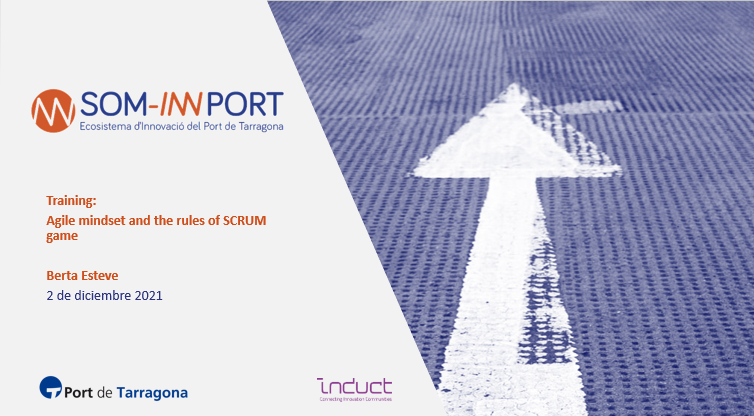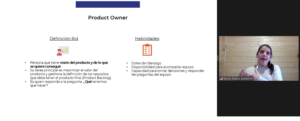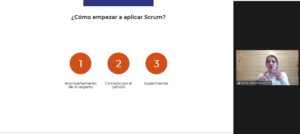
Training: “Agile mindset and the rules of SCRUM game” by Berta Esteve
On the 2nd of December, we carried out new training activities, in streaming, within the program of activities of the Open Innovation Cycle 2021 of SOM-INN PORT, on “Agile mindset and the rules of the SCRUM game” by Berta Esteve. The aim was to offer tools for managing teams working in situations with a high degree of uncertainty and risk, such as innovation projects.
The training was given by Berta Esteve, Director of user-centricity at SDLI. Agile innovation methodologies are becoming more and more popular, the trainer started talking about the Agile mentality comparing the so-called waterfall development and Agile development. On the one hand, waterfall development is sequential, has a rigid structure and is quite resistant to change. On the other hand, Agile development is non-linear, the requirements are constantly evolving and it has a flexible procedure, which makes it adaptable to change. The latter is what the Agile mindset is based on and its main objective is the constant delivery of value as fast as possible in order to constantly validate the solution with the customer.
Agile is a mindset based on 4 key values:
- Individuals and interactions over processes and tools: Communication between teams is fundamental.
- Collaboration with the customer: Involve the customer in the process and validate the solution with them on an ongoing basis.
- Functional: Deliver a functional solution that the customer can interact with in order to receive feedback.
- Responsive to change: Be open to modifications.
Agile focuses on meeting customer needs quickly and continuously is highly adaptable to change and prioritizes the creation of a functional solution. It has a flexible development which leads to constant reflection on customer feedback and adjusting the solution according to their needs. At the organizational level, it works together with teams responsible for business and developers who must be motivated and self-organized.
The Agile mentality has brought a new organizational model. It has moved from a vertical hierarchical structure to a flexible structure based on self-managed teams without any hierarchy.

The main benefits of Agile are Alignment and productivity driven by the efficiency of self-managed teams; the ability to adapt to change by not having a linear structure; risk reduction, as the solution is validated with the client on an ongoing basis; client satisfaction by seeing value delivered continuously; and team satisfaction by being self-managed. It has also been proven that solutions worked within the Agile framework significantly reduce time-to-market.
SCRUM framework
The second part of the session focused on the SCRUM framework. Agile is the umbrella under which several methodologies fall, one of them being SCRUM, which focuses on how to develop the solution. SCRUM is a management framework for product development, which focuses on maximizing value.
This methodology is based on planning and executing tasks in project teams with an empirical and iterative approach.
Its objective is to transmit value, manage the project process, avoid deviations and focus on business objectives.
SCRUM is based on 3 fundamental pillars:
- Transparency: All members have information about the process.
- Inspection: Constant review to detect possible deviations.
- Adaptation: Capacity to adapt and adjust according to the needs that arise.
Roles in SCRUM:
The SCRUM team is made up of a small group of professionals who are self-managed and focused on the same objective. In the same team there are 3 different roles:
- Product owner: Has a vision of the product and what is to be achieved. Their main task is to maximize the value of the product and manage the definition of the requirements.
- Scrum Master: Their main task is to ensure that the SCRUM methodology is applied correctly and to ensure the well-being of the team.
- Developers: These are people committed to creating value through deliverables.

Events in SCRUM:
Sprints are the core of the SCRUM method. It is the basic unit of work and consists of an iteration of approximately one month where different events are carried out to achieve the Sprint Goal.
The first event within the SCRUM framework is the vision and roadmap where the value proposition, objectives and KPIs are defined. Subsequently, we enter into the SPRINT itself, which encompasses:
- Sprint Planning: This consists of a meeting with all the members of the SCRUM team to define the specific objective of the Sprint and how the tasks will be developed.
- Daily: This is a daily meeting with all the developers to communicate what is being done, what problems are arising and how they will be solved.
- Sprint Review: This is a meeting with all members of the SCRUM team where the results of the executed work are presented and possible adaptations are discussed.
- Sprint Retrospective: This is a meeting on the last day of the Sprint with all members of the SCRUM team to analyse the efficiency with which the tasks have been carried out and to identify changes for improvement.
SCRUM Tools
Three tools were also mentioned within the SCRUM framework. Firstly, the Product backlog which is a prioritized list of product requirements. It is essential that it is defined in order for the team of developers to start working. Secondly, we have the Sprint Backlog which consists of a list of requirements to be developed in a specific Sprint and the action plan to carry them out. Finally, we have what is called the increment, which is the result of the Sprint.
Finally, Berta Esteve gave some recommendations to start applying this methodology. It is recommended to select a pilot project to test and see how this methodology fits within the organization. It is necessary to select a highly motivated team and define clear objectives and metrics from the very beginning.

Many thanks to Berta Esteve for sharing her knowledge about Agile and Scrum with the members of Som-Inn Port and to all of you who joined us in this session.
14th December 2021
Department of Studies and Innovation

43004 Tarragona

Contacta amb nosaltres
+34 977 259 400
Passeig de l'Escullera, s/n,
43004 Tarragona


